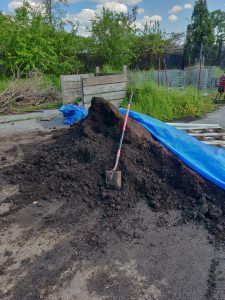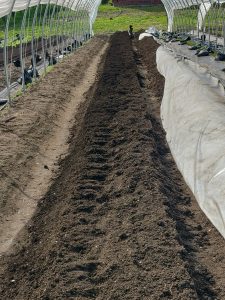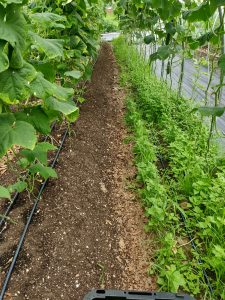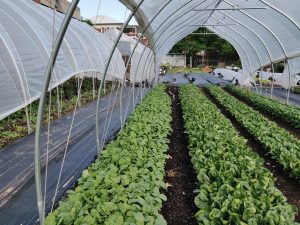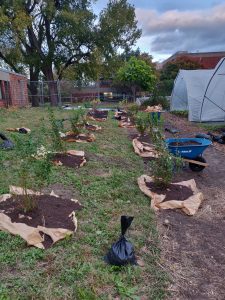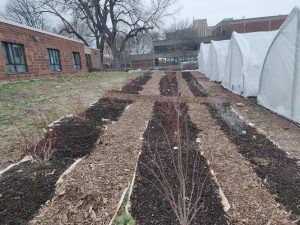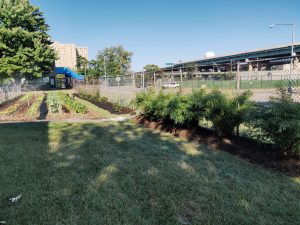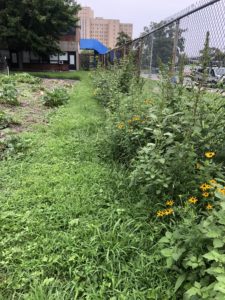Final report for FNE19-917
Project Information
As urban farmers, we have found few examples of ecological production farming adapted to major metropolitan areas. The purpose of this SARE grant was to apply a set of agroecological techniques to one of our farm sites, and document the process and benefits to share with the broader NYC urban agriculture community.
Our grant experiment contained two primary interventions: 1) convert half our production space to deep compost, no-till operations, and 2) plant two hedgerows of young perennials for the various ecosystem services they provide. We tracked labor hours required to build the no-till beds and cultivate, days from seed to maturity/harvest, and harvestable yields per square foot across the season (~8 months). We also began tracking as many insect and animal species as possible to see whether the hedgerows increased biodiversity.
This project seeks to 1) compare the efficacy of deep compost, no-till production techniques against our current tillage practices on the farm. Within the first year, we expect that the labor hours required for weed management of the no-till production space will decrease, and that harvestable crop per square foot (a measure of quality and pest impact) will increase — both against control beds. We hypothesize that no-till will reduce labor hours by 20%, freeing up enough staff time to justify activating 4 new 100 row feet beds in the following season.
This project also seeks to 2) install two perennial hedgerows (adapted from the Singing Frogs Farm model), and track pest and beneficial species on the farm across three years. Because our transplants will be young, we expect a gradual increase in our identification of beneficial plants and animal beginning in year two.
If these objectives are met, we believe our interventions demonstrate that a more complex ecology is forming on the farm by attending to the health and diversity of the soil and the landscape.
Project EATS is a nonprofit in NYC focused on using production agriculture to 1) offer fresh produce to communities marginalized by our food system, 2) expose youth to the viability of farming as a profession, and 3) foster agency over neighborhood resources and skill sets. In addition to managing three farms using raised beds on concrete, the organization operates a 1+ acre site (Help Sec), growing in clean, native soil. Though committed to addressing the social, financial, and political elements of farming and food for 10 years, the organization has only recently begun to ensure that the non-human habitat built to supply its local food chain is cared for and improved. In the 2019 season, we intended to reevaluate our current agriculture practices and trial new production techniques at the Help Sec farm.
Through research and experiences on other farms, we are swayed by the ongoing scientific arguments that mainstream and ubiquitous tillage negatively impacts soil ecologies and the ecosystems services they afford (carbon sequestration, predator-pest harmonization, improved plant health, water storage and filtration, etc)1,2,3. Additionally, we are aware that biodiverse environments with intact soil ecologies as a foundation offer landscape “antifragility”4, improved buffering against inclement weather events5, and lengthening of the growing season6. Searching for an alternative production approach that 1) cares for healthy topsoil and biodiverse landscapes and 2) aligns with Project EATS’s mission/vision of reinvigorating communities’ interest and autonomy in their own food system, we centered on the philosophy and methodology of regenerative agriculture.
Multiple case studies of regeneratively-focused farms exist in the northeast, but we have difficulty finding successful examples of ecological production farming applied to an urban context. We therefore aimed to use this grant to adapt regenerative techniques to the city's ecosystem and resource base it offers. In our application, we proposed two primary interventions:
- convert half of Help Sec’s production space to no-till operation with deep compost mulching
- establish perennial hedgerows for habitat/forage for beneficial and predatory insect, creation of microclimates, and diversified produce offerings.
Should these interventions be successful, we hypothesize the impacts will improve the health and yield of crops, reduce labor inputs for cultivation and pest management, and reduce fertilization inputs.
Being well connected to NYC’s urban farming community and the challenges of growing in a predominantly concrete environment, we are aware that the city has few production farms focusing on sustainable agricultural practices, per SARE’s definition. We have spoken with a wide variety of farmers, gardeners, educators, agriculture technologists, and interested residents who express the need for and enthusiasm in learning from an ecologically driven urban farm. Having access to a diverse audience and huge population of people, we are also oriented to exposing urban folks to the tenants of regenerative farming, ecological management, systems based thinking, and the rural stewardship of farmers supplying the city’s food requirements. We also see this grant as an opportunity to:
- Document the farm’s transition towards ecological practices, share all results with other urban farmers, and develop relationships to divert urban-based resources from the waste stream
- Offer our farm as a resource to programs focused on urban farming education, such as Farm School NYC, AgTech-X, and the public high schools whose students participate in our farm training
- Foster more detailed discussion about the possibilities of sustainable agriculture, environmental justice, and food access within the urban farming/gardening communities
- Continue developing partnerships and entrepreneurialism in urban farming, emphasizing the environmental benefits of using these techniques when growing food in the city.
Citations
- Farmland LP. 2017. Valuing the Ecosystem Service Benefits from Regenerative Agriculture Practices.
- Ingham E. Soil Food Web. <https://www.nrcs.usda.gov/wps/portal/nrcs/detailfull/soils/health/biology/?cid=nrcs142p2_053868>
- Toensmeier E. 2016. The Carbon Farming Solution. Chelsea Green Publishing
- Taleb, Nassim. 2014. Antifragile: Things that Gain from Disorder. Random House Trade Paperbacks.
- De Boeck H, Bloor J, et al. 2017. Patterns and Drivers of Biodiversity-Stability Relationships Under Climate Extremes. Journal of Ecology, 106(3), 890-902.
- Oehri J, et al. 2017. Biodiversity Promotes Primary Productivity and Growing Season Lengthening at the Landscape Scale. Proceedings of the National Academy of Sciences, 114(38).
Project EATS broke ground for the Wards Island “Help Sec Farm” in 2012. The Farm has an acre of diversified vegetable production, including leafy greens, root vegetables, fruiting crops, and herbs. On average, we gross approximately $50,000 in sales, with two full-time farmers. The markets we serve include six restaurants, six farm stands, two ‘farmacies’ (doctors give patients food prescriptions that they fulfill through us at a subsidized cost), and two food donation centers.
As a lead farmer at the Help-Sec Farm, I have an interdisciplinary, systems-based education and three years of well-rounded agriculture experience, ranging from controlled-environment, hydroponic, and soil farming. Prior to working at Project EATS, I was operating and managing a half-acre private estate farm. I am also an active member of the NYC urban agriculture community. I have co-organized the NYC Agriculture Collective and co-managed AgTech Week for two consecutive years, attended events organized by the NYC CRAFT (Collaborative Regional Alliance for Farmer Training) group, taught classes for Farm School NYC, spoken on the “Growing Food, Growing Power: The Future of Urban Agriculture in NYC” panel at the 2018 Just Food Conference, and in 2019 began organizing around the creation of an NYFC city chapter.
Cooperators
- - Technical Advisor (Researcher)
- (Educator)
Research
This project sought to 1) compare the efficacy of deep compost, no-till production techniques against our current tillage practices on the farm, and 2) install two perennial hedgerows (adapted from the Singing Frogs Farm model), and track pest and beneficial species on the farm across three years.
- The first intervention involved converting half of the farm’s production space into an experimental plot, and comparing its performance against our current tillage practices on the farm (control plot). Both plots had the same number of beds and similar environmental conditions. Three chemical and biological soil tests per plot were taken in early spring to establish a baseline. We intended to consult with our technical adviser, Yolanda Gonzalez from Harvest New York, to interpret the soil tests and create an appropriate amendment schedule for the season. A month later, we sought consultation from Paul and Elizabeth Kaiser from Singing Frogs Farm to review the logistics of no-till farming and ensure that we had identified any confounding variables that may impact our tracking protocols and seasonal operations. We then located and vetted high quality compost sources that were pH balanced, weed free, and could be deliver into the city. We modified our crop plan to reflect the same or similar crop allocation between the test and control plots. For example, both plots included the same number of beds for short growth cycle/high yield leafy greens (ie spinach and lettuce), root vegetables (beets and carrots), longer lifespan crops (scallions), and longer yielding crops (kale and collards). Based on best practices from other no-till farms, all beds in the test plot were stale seeded and six inches of compost was applied to smother any remaining weeds. Both plots shared the same weed management schedule and time/task data collection spreadsheet. This data was collected across 8 months of production under the premise of maintaining a farm where no weed was allowed to grow beyond the first true leaves. We also tracked and compared days from seed to maturity/harvest and harvestable yields per square foot (/ft2) in weekly 25’ allotments for both plots across the same 8 months. “Harvestable” was a qualitative metric and was based on our organization’s quality criteria for produce. At the end of the season, we took the same chemical and biological soil tests for each plot to compare against baseline. Labor breakdown for weed management, days from seed to maturity, and harvestable yields/ft2 data for both test and control plots were compiled and analyzed side-by-side. We interpreted and reported on: 1) whether the chemical/biological make up of the test plot had deviations from baseline and from the control plot, 2) whether the input costs of compost were recouped by savings from higher harvestable yields/ft2 and reduced weeding labor, 3) the difference in labor allocation per bed and how many new beds could be activated based on those savings in labor, and 4) whether changes in seed to maturity data justified tighter crop successions for the following season. This data analysis was conducted in Excel and did not require any statistical analysis.
- The second intervention involved installing perennial hedgerows to provide microclimate and beneficial/predatory insect habitat. We conducted a landscape analysis to identify pressures such as seasonal prevailing winds, high weed zones, and key insect presence from the 2017 and 2018 seasons. Knowing insects will travel up to 80 feet from hedgerows to prey on pest insects, we overlaid this parameter with our landscape analysis to determine the best locations for hedgerows. We then consulted Singing Frogs Farm, Yolanda Gonzalez from Harvest New York, and the greater Cornell University research network to source the latest evidence-based knowledge on predatory insect and their preferred habitat. This research was used to create a list of native and/or edible perennial shrubs. Species selection and planting arrangement were based on recommendations from consultations, agroforestry principles, and sourcing availability within the NYC metro area. We then took two days each season (spring, summer, fall) to scout for all unique insects/animals and identified key predatory/beneficial insects. We noted any biological or chemical controls used to keep plant damage at acceptable levels. We used iNaturalist to document as many creatures as possible. We did not intend to obtain actionable results from the first year of data collection, but across three years we expect to find beneficial trends in pest/predatory insect presence, and an overall increase in insect/animal diversity as a more ecological landscape is established.
-
C:N ratio of 15-18:1,
-
pH close to 7
-
ammonia readings (mg/kg) of <5
-
CO2 evolution rate <1
-
a curing phase >6 months
-
incorporation of multiple feedstocks (ideally including manures)
-
weed free
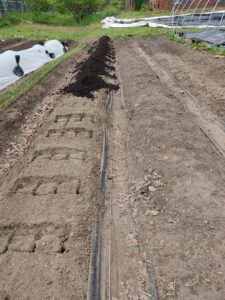
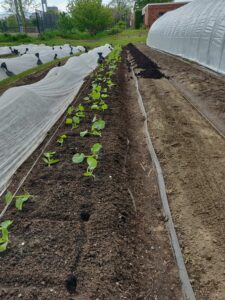
-
Labor breakdown for weed management
-
Days from seed to maturity
-
Harvestable yields/ft2
-
Soil analysis
|
|
Control beds
(bare soil)
|
Experimental beds
(compost)
|
|
Number of beds
|
19
|
21
|
|
Total cultivation time (min)
|
1,986
|
779
|
|
Total cultivation time (hr)
|
33.1
|
13.0
|
|
Avg cultivation time per bed (hr)
|
1.74
|
0.62
|
|
Crop
|
Control Yield (lbs)
|
Control Row Feet
|
Control Yield Ratio (lbs/row ft)
|
Experimental Yield (lbs)
|
Experimental Row Feet
|
Experimental Yield Ratio (lbs/ft)
|
|
Beets
|
113.78
|
950
|
0.12
|
180.83
|
1,050
|
0.17
|
|
Cucumber - pickling
|
351.62
|
2,550
|
0.14
|
247.73
|
1,950
|
0.13
|
|
Cucumber - slicing
|
253.39
|
2,750
|
0.09
|
276.19
|
2,450
|
0.11
|
|
Pac Choi
|
19.80
|
400
|
0.05
|
90.87
|
1,900
|
0.05
|
|
Parsley
|
231.40
|
1,610
|
0.14
|
155.20
|
915
|
0.17
|
|
Tomatoes - cherry
|
517.22
|
7,800
|
0.07
|
533.47
|
7,350
|
0.07
|
|
Tomatoes - slicing
|
970.60
|
10,200
|
0.10
|
1,487.28
|
10,900
|
0.14
|
|
|
2019
|
2020
|
||||
|
Spring
|
Summer
|
Fall
|
Spring
|
Summer
|
Fall
|
|
|
Number of unique animal observations
|
48
|
109
|
32
|
--
|
--
|
--
|
|
Number of beneficial or predatory insects identified
|
9
|
19
|
4
|
--
|
--
|
--
|
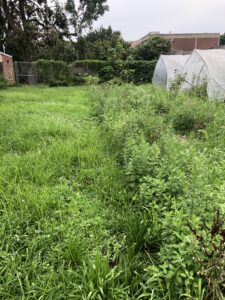
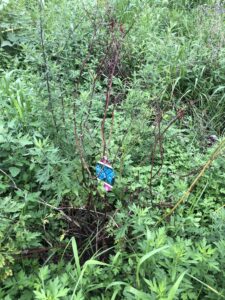
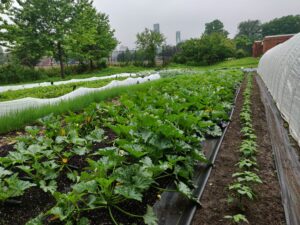
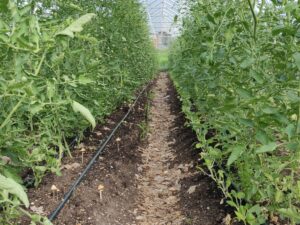
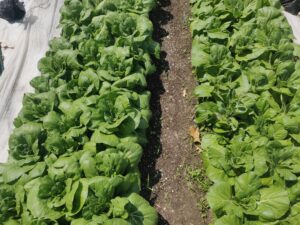
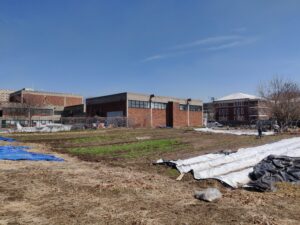
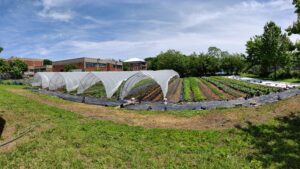
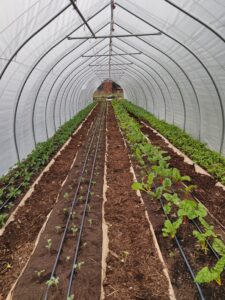
Education & Outreach Activities and Participation Summary
Participation Summary:
Our primary outreach method for this grant was tours for volunteer groups, CSRs, and donor visits. Farming in a major metropolitan area where most people are cut off from their food sources, we believe in educating the public about the realities of agriculture as often as possible. With each tour, time was dedicated to explaining our research objectives and the philosophy and importance of ecological farming.
The farm was also in close proximity to a trade school that had an outdoor garden and hydroponic rooftop greenhouse. We were able to host students on the farm and give them ideas about incorporating no-till techniques to their garden. Before leaving, the author was in communication with a school teacher about starting a part time apprenticeship program for 2020 students based on seeing the farm and results of the grant experiment.
Committed to participating in NYC's urban agriculture community, we also hosted two educational events open to our network. Our CRAFT (collaborative regional alliance for farmer training) event brought together mostly farm/garden managers to report on the ongoing outcomes of the grant. And hosting a Farm School NYC class allowed students to learn about our objectives and participate in on-farm activities.
Lastly, although no longer working for the nonprofit farm, the author discussed aspects of the grant with others during NYC's TUFFS conference in 2020. A short slide deck was created and shared based on pictures and results throughout the 2019 season.
Learning Outcomes
A key area where farmers reported a change in knowledge involved better understanding the role of weeds on the farm and how to reduce their ecological niche. Demonstrating successful examples of how minimal tillage and compost mulching can reduce weed pressure encouraged 5 farmers to report that they had changed some of their soil management strategies for the remainder of the year. Another farmer reported that learning how about ecological succession would help both her annual production and her maintenance of perennials bushes on her farm. Describing out selection criteria for perennial hedgerows also shifted two farmers awareness of the benefits of biodiversity not just within production but throughout the farm.
Of the four coworkers I had during the season, all of them reported that the soil management strategy introduced during the season was beneficial for operations, and that they would want to expand those techniques to the full farm in 2020.
Project Outcomes
Anecdotally, myself and the farmers I worked with reported that there was an obvious difference in the weed pressure throughout the season, and that weed management became less of a day-to-day stress. Though there was a large upfront investment of labor hours in applying compost to the fields, less labor hours were spent on cultivating experimental beds than control beds throughout the season. The benefits of this time reduction meant farmers could focus on other aspects of farm operations, and had to bend over to hand weed less (physical quality of life improvement).
Another outcome was that crops grown in the experimental bed appeared healthier and less stressed than in control beds. As an example, crops would bolt slower in composted beds than in bare soil beds. Yields may have improved in composted beds, but that data isn't definitive.
In another outcome, reduced weed pressure in composted beds allowed for more successful management of interplanted crops. Crops along the edges of vertically trellised tomato and cucumber beds had little competition from weeds and therefore were easier to harvest from and had more consistent growth.
These changes in soil care management and the introduction of hedgerows on the farm created a more aesthetically pleasing work space -- significant because the farm frequently has volunteers, CSRs and visiting donors. The aesthetic change created a psychological feeling of organization and cleanliness, reducing the anxiety of managing certain beds during the height of the season.
Overall this project was a beneficial experience to myself, our farm staff, visitors/volunteers, and other urban farmers who came to our CRAFT meeting. For myself and the staff, we were required to rethink the reasons and methods of managing the farm. Being able to see significant changes to the farm throughout the season also reinforced the benefit of shifting our production mindset. For visitors and volunteers, many of them were thankful for the chance to contribute to an ecologically managed farm. It was also enjoyable for volunteers to engage in tasks like planting perennial shrubs or dumping compost, when they were only expecting to be hand-weeding.
The agroecological techniques we used in this project have a long history of success on other farms, and we believed that they would be equally useful in an urban context. Though we saw a qualitative confirmation of this assumption, some improvements in our methodology are needed to make more robust quantitative conclusions.
Composted, no-till beds
Part of our methodology involved testing the soil of experimental/control beds before and after the 2019 season. We were aiming to discover whether laying compost as a biological inoculant on top of native clay soil would create a noticeable change. In hindsight, since we were not tilling compost into the soil, vertical migration of microbiology had to come from soil being mixed while transplanting or broadforking, or microbes leaching into the clay soil from rain water or irrigation. Without any appreciable difference in soil tests after the 2019 season, it’s reasonable to assume that this deep compost, no-till production system requires more time to create biologically active soil 6 inches down or deeper. Additionally, the soil tests we used only describe the nutrients in the soil but not what the plant is taking up. Since the mission of the farm was to produce nutrient rich food, we believe it would have been more beneficial to use plant sap analysis to measure nutrient absorption in plants. If adding inoculated organic matter and preserving soil structure (and thus biological activity) through no-till contributes to nutrient absorption processes such as rhizophagy, plant sap analysis may have better indicated whether plants grown in experimental beds were healthier against control.
As discussed in the results section of this report, “days from seed to maturity” was also an unreliable metric in our methodology. There are too many confounding variables affecting a crop’s maturity, and this metric would have been left out if doing this project again. A labor breakdown for weed management and tracking yield in experimental/control beds was valuable data to collect. This information greatly contributed to understanding the success of this project, and confirms our initial assumptions that deep compost, no-till production would improve yields and reduce cultivation labor.
Overall, we were satisfied with the results of this project, and planned on expanding this production technique onto the whole farm. The author managed a different farm in 2020 and used the same bed system with good outcomes. We also believe the deep compost, no-till methodology is applicable to all growing operations in the city. Between many community gardens having compost operations and the city’s sanitation department giving out compost to urban farms/gardens, this resource is readily available for urban farmers. In the least, we advocate that a deep compost mulching without soil disturbance does well for weed suppression.
We do want to note that over 100 cubic yards of compost were brought onto the farm for this project. Fortunately, we had an asphalt area on the farm that could to host this much material, but most urban farms do not have extra space. The logistics of holding compost on-site to move into beds could be a biggest complication for urban farms trying to adopt this production technique.
Perennial Hedgerows
Unfortunately, the author was not able to manage the hedgerows into the second year of this grant. We believe our methodology for this portion of the grant was practical, but insect identification was a weakness to accurate multi-year reporting. iNaturalist was a useful tool for identifying insect species and getting confirmation from etymology experts. However, there were many insects that could not be captured using a cell phone camera, and it was the author’s best guess to differentiate these species. Scouting for year two of the project would confirm new or enduring species if pictures of those insects could be uploaded through iNaturalist. For smaller insects, the only functional metric for documenting change would be counting the total number of unique species between the two years.
Although most urban farms/gardens can’t accommodate larger hedgerows, perennial species in pots or hung vertically around the growing space could act as trap crops or “wild” spaces and contribute to the biodiversity of the farm. Unfortunately, this grant would not be able to provide data showing that these plantings are beneficial in an urban setting. Nevertheless, we would still promote the principles of hedgerows to fellow urban growers.
